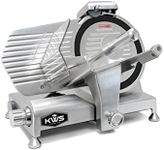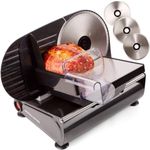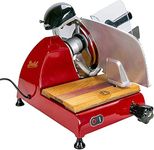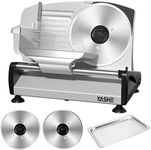Buying Guide for the Best Meat Slicers
Choosing the right meat slicer can make a significant difference in your kitchen, whether you're a home cook or a professional chef. A meat slicer allows you to cut meats, cheeses, and other foods with precision and consistency, saving time and effort. When selecting a meat slicer, consider the frequency of use, the types of food you'll be slicing, and the space available in your kitchen. Understanding the key specifications will help you make an informed decision that suits your needs.Blade SizeThe blade size of a meat slicer determines the thickness and size of the slices you can achieve. Blade sizes typically range from 7 to 14 inches. Smaller blades are suitable for home use and lighter tasks, such as slicing deli meats and cheeses. Larger blades are ideal for commercial use or for slicing larger cuts of meat. Consider what you'll be slicing most often; if it's larger roasts or bulk meats, a larger blade will be more efficient.
Motor PowerMotor power is crucial for determining how efficiently a meat slicer can cut through different types of food. Measured in watts, higher motor power means the slicer can handle tougher meats and larger volumes without overheating. For occasional home use, a lower wattage motor may suffice, but for frequent or commercial use, a higher wattage motor will ensure durability and consistent performance. Assess your slicing needs to choose the right motor power.
MaterialThe material of a meat slicer affects its durability and ease of cleaning. Common materials include stainless steel and aluminum. Stainless steel is robust, resistant to rust, and easy to clean, making it ideal for heavy-duty use. Aluminum is lighter and may be suitable for less frequent use. Consider how often you'll use the slicer and how much maintenance you're willing to perform when choosing the material.
Adjustable ThicknessAdjustable thickness allows you to customize the slice thickness according to your needs, ranging from paper-thin to thick cuts. This feature is important for versatility, especially if you plan to slice a variety of foods. Look for slicers with easy-to-use adjustment mechanisms. If you need precise control over slice thickness for different recipes, ensure the slicer offers a wide range of thickness settings.
Safety FeaturesSafety features are essential to prevent accidents while using a meat slicer. Common safety features include blade guards, non-slip feet, and safety locks. These features help protect your hands and ensure stability during operation. If you have children or are new to using meat slicers, prioritize models with comprehensive safety features to minimize risk.
Ease of CleaningEase of cleaning is important for maintaining hygiene and prolonging the life of your meat slicer. Look for models with removable blades and parts that are dishwasher safe. This will make cleaning more convenient and ensure that all components are thoroughly sanitized. If you plan to use the slicer frequently, choose one that offers straightforward cleaning options to save time and effort.















